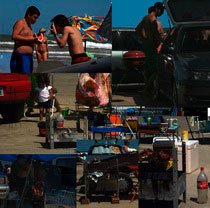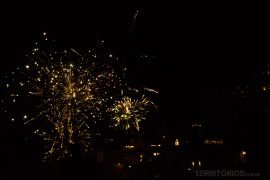It really is a unique beach – besides being the largest one (over two hundred kilometres) – and unusual things happen, like nowhere else in Brazil. On a buggy, motorbike or 4×4 it is possible to travel on the shore until Uruguay.
[highlight]Leia em Português[/highlight]
The Cassino Beach

It is the only beach I know from a group of beaches, where the cars get to the sea shore. There is traffic jam, four lines of cars passing by and another four of parked cars. All this on the wide extension of sand between the dunes and the sea; of course, this hustle is in the residential area, not along the whole beach. People walk among the cars, which protect them on windy days. On other days, the tourists sunbathe with their back to the sea, so they can enjoy the crowd – people, cars, buggies, bikes, motorbikes, vans, motor homes and even trucks. By the way, the bars are cars that stay throughout the summer. In the winter the beach is completely empty, only a few fishermen and surfers are seen.
There are small tsunamis, sand storms and the weather can change so fast that it is very likely the cars jam or flood if they are unattended and the weather suddenly changes. When this happens is chaos, few minutes between seeing a black cloud getting closer, gathering the stuff and joining the traffic jam. I have never been in a tsunami, but many people say they saw a huge wave breaking on the shore, destroying lots of things. It appeared on the news once, a giant wave invaded over five blocks, considering that the distance between the sea and the houses is quite large.
It is not a beautiful beach like many others in Brazil, but it is the southern sea; it is pleasant, people know each other, there is infrastructure and I have great memories of my childhood and teenage years. I remember the sea used to be more violent, today is just like a lagoon. There were crabs that bit the tourists’ big toes and tatuíras* that stung the feet. Where did they go?
Besides having everything a big beach in Rio Grande do Sul offers, there is the tour at Trilhos Dos Moles, where a sail wagon takes you to high seas and the Oceanographic Museum – responsible for penguins and sea lions that get lost – among other attractions. There is also a Stranded Ship at the least crowded part.
On the weekends, people spend the whole day at the beach; they pack snacks, drinks, chimarrão (tea), barbecues, tents and everything they need. On a classic Sunday in January, I got some details of Cassino:

* small crustaceous from Brazilian beaches that live right below the sand surface
© All rights reserved. Pictures and report 100% originals.
Translated by Lúcia Maciel
English teacher









